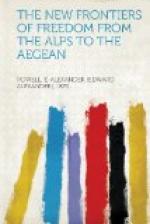We touched at Sebenico, which is forty knots down the coast from Zara, in order to accept an invitation to lunch with Lieutenant-General Montanari, who commands all the Italian troops in Dalmatia. Now before we started down the Adriatic we had been warned that, because of President Wilson’s attitude on the Fiume question, the feeling against Americans ran very high, and that from the Italians we must be prepared for coldness, if not for actual insults. Well, this luncheon at Sebenico was an example of the insults we received and the coldness with which we were treated. Because our destroyer was late, half a hundred busy officers delayed their midday meal for two hours in order not to sit down without us. The table was decorated with American flags, and other American flags had been hand-painted on the menus. And, as a final affront, a destroyer had been sent across the Adriatic Sea to obtain lobsters because the general had heard that my wife was particularly fond of them. After that experience don’t talk to me about Southern hospitality. Though the Italians bitterly resent President Wilson’s interference in an affair which they consider peculiarly their own, their resentment does not extend to the President’s countrymen. Their attitude is aptly illustrated by an incident which took place at the mess of a famous regiment of Bersaglieri, when the picture of President Wilson, which had hung on the wall of the mess-hall, opposite that of the King, was taken down—and an American flag hung in its place.
The most interesting building in Sebenico is the cathedral, which was begun when America had yet to be discovered. The chief glory of the cathedral is its exterior, with its superb carved doors, its countless leering, grinning gargoyles—said to represent the evil spirits expelled from the church—and a broad frieze, running entirely around the edifice, composed of sculptured likenesses of the architects, artists, sculptors, masons, and master-builders who participated in its construction. Put collars, neckties, and derby hats on some of them and you would have striking likenesses of certain labor leaders of to-day. The next time a building of note is erected in this country the countenances of the bricklayers, hod-carriers, and walking delegates might be immortalized in some such fashion. I offer the suggestion to the labor-unions for what it is worth.
Throughout all the years of Austrian domination the citizens of Sebenico remained loyal to their Italian traditions, as is proved by the medallions ornamenting the facade of the cathedral, each of which bears the image of a saint. One of these sculptured saints, it was pointed out to me, has the unmistakable features of Victor Emanuel I, another those of Garibaldi. Thus did the Italian workmen of their day cunningly express their defiance of Austria’s tyranny by ornamenting one of her most splendid cathedrals with the heads of Italian heroes. Imagine carving the heads of Elihu Root and Charles E. Hughes on the facade of Tammany Hall!




